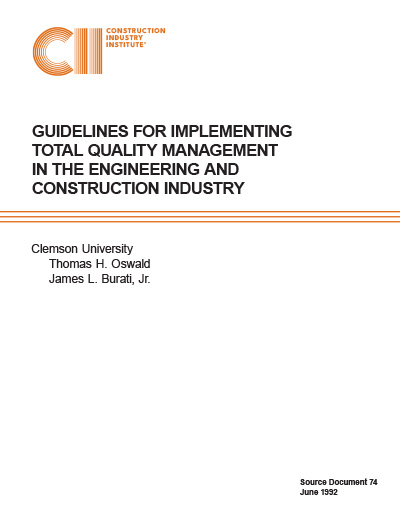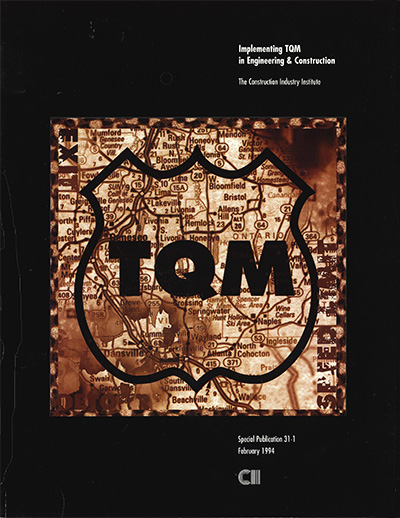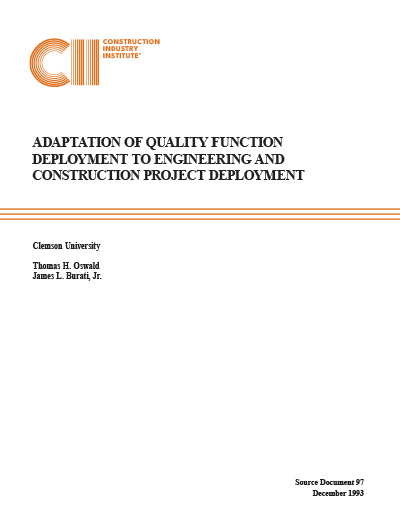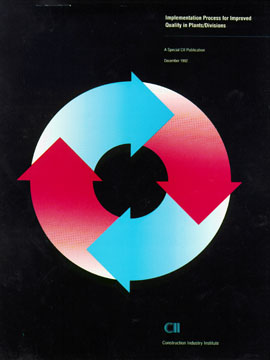
Guidelines for Implementing TQM in the Engineering and Construction Industry
Total Quality Management: A Strategic Necessity
This research is based on the premise that continuous improvement in the management of the engineering and construction (E&C) industry is a strategic necessity, both for the United States and for the companies that make up the industry.
As one of the largest contributors to the gross national product, the E&C industry bears a significant national responsibility to use the most efficient management practices available. This fact was highlighted in a 1989 study by the Construction Industry Institute (CII), which concluded that:
|
Companies must institute total quality management (TQM) or become noncompetitive in the national and international construction and engineering markets in the next five to ten years. |
From the viewpoint of the individual company, the strategic implications of TQM include:
- Survival in an increasingly competitive world.
- Better service to its customers.
- Enhancement of the organization’s “shareholder value.”
- Improvement of the overall quality and safety of our facilities.
- Reduced project durations and costs.
- Better utilization of the talents of its people.
Why This Project Was Commissioned
The Construction Industry Institute (CII) commissioned this research in recognition of:
- The strategic importance of Total Quality Management in the industry, and
- The need for a comprehensive set of TQM implementation guidelines, reflecting the structure, the experience, and the unique needs of the engineering and construction (E&C) industry.
This report is intended to provide such guidelines, based on the implementation experience of 17 major U.S. companies. Additional background on the research is provided in Appendices A and B.
Corroboration by Current Events
CII’s 1989 perception has been borne out over the 18-month period of the research leading to this report.
- Competition is becoming ever more intense. Foreign contractor volume in the U.S. market doubled in the five years from 1985 to 1990.
- Domestic E&C competition also is intensifying. Industry leaders surveyed in this research provided unequivocal corporate testimony on the positive effects of TQM implementation on the acquisition of new business, and equally as important, on the retention of existing clients/contractors.
- The prolonged economic recession has intervened, bringing profound changes in business’ perception of what constitutes cost-effective structure and operating concepts.
Intended Audience
The intended audience for this report includes both CII member and non-member companies who are involved in any significant way with the overall E&C process. Within each category there are companies who literally “helped write the book,” companies which have begun their TQM implementation but sense a need for redirection of their efforts, and companies that sense a need to get into TQM but have no idea how to do it. The report has something for all of them.
The report is written from the viewpoint of owners, through their engineering and construction departments, and contractors, primarily those classified as engineering/procurement/construction (EPC) firms. Nevertheless, all types of contractors—design, construction, design-construct, construction management, specialty contractors, etc.—will find the report useful.
Major Findings
The report is based on comprehensive interviews of 17 major companies involved in the E&C industry: eight owners and nine contractors. Their TQM experience has ranged from four to ten years. Appendices A and B provide background and details, including a table giving company characteristics. No company or individuals’ names are mentioned in this report, to preserve confidentiality.
The major findings are:
- There is no universal, “cookbook” approach, although there is a general sequence of implementation phases which seems to produce the best results. Chapter 2 gives an overview of these four phases, and the subsequent chapters expand on their major action components.
- The common features of successful TQM systems are:
- Corporate attention is focused on meeting customers’ requirements.
- Senior management personally and persistently leads the building of Quality values into the company’s operations. (This single finding eclipses all the rest. If this does not happen, Quality Improvement does not happen.) Chapter 3 is dedicated exclusively to the critical role that management plays in the implementation process.
- Employees are suitably trained, empowered, and involved in continuously improving Quality and reducing costs.
- The progress or speed of TQM implementation is enhanced if systematic processes are established and integrated in the organization to foster continuous improvement. E&C companies have learned from other industry companies who “went before,” but only by means of informal and fragmentary research. These Guidelines should assist additional organizations to implement TQM even more efficiently.
- Traditional reservations about the practicability of TQM in field engineering and construction activities are invalid. Chapter 9 provides hard evidence that TQM and the “project process,” including field operations, are entirely compatible.
- TQM is truly a bottom-line issue. Chapter 10 presents a model, validated many times over by one of the host companies, which shows how the organization’s “shareholder value” is enhanced by the improvement of its processes. Case examples are presented of improved customer satisfaction, reduced cycle times, documented cost savings (benefit/cost ratios of nearly 500%), and more satisfied and productive work forces.
How to Use This Report
The TQM Task Force of CII has encouraged the production of a concise set of guidelines that are customer focused and “user friendly” in both content and format.
In using the report, readers are encouraged to:
- Read and consider all of it. TQM is a densely interlaced network of simple concepts. Implementation in only one or several of the chapter subject areas has been tried, and the resulting journeys toward sustained Quality Improvement have produced high costs but low realization of benefits.
- Chapter 2 presents a comprehensive “roadmap” for successful implementation, from management’s initial perception of a need to change, to the point at which TQM is woven into the operating fabric of the company. Readers are encouraged to thoroughly study this overview to obtain an appreciation of the full sweep and sequence of implementation before initiating any specific actions.
- Understand that, despite the size and complexity of the participating companies, these guidelines can be scaled to smaller organizations. (Note that “scaling” still implies using all of the principles, but at a level of effort that is appropriate to the organization and its business scope. Scaling does not mean, for example, forming teams but leaving out the planning phase.)
- View the information presented as a composite of successful implementation experience. Do not evaluate a particular implementation concept or procedure based on the “number of companies reporting doing it.” This is a statistically based study. Companies were selected based on their known success in implementing TQM. Some of the most innovative and promising ideas were reported by only one or very few of the companies. Such is the nature of innovation.
- Keep in mind that this is an account of successful practice to date (of the interviews) in the interviewed (“host”) companies, and that TQM implementation is highly dynamic. The “Roadmap for Implementation” presented in Chapter 2 has no end point. In the time since the interviews were completed, doubtless every host company has made improvements to its processes. Nevertheless their foundation experience remains valid and should be carefully considered by companies making new starts or midcourse corrections.
Recommendation
If you sense a need to influence your organization’s future course to realize the strategic benefits cited in the opening section, then:
- Read this report.
- Get competent outside help.
- Tailor your implementation based on these industry-leading concepts and practices, and in relation to your desired business results.
- COMMIT TO THE JOURNEY, and GET STARTED!



